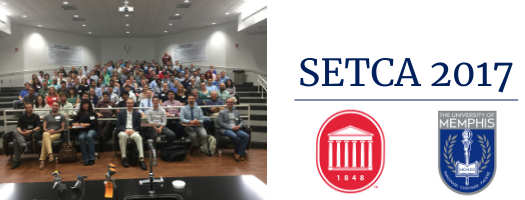Location
Coulter Hall, Room 211
Start Date
20-5-2017 8:50 AM
Description
The B1 domains of protein G (GB1) and protein L (LB1) are two small proteins that bind to antibody immunoglobulin G (IgG). GB1 and LB1 are similar in size (about 60 residues), and also have an overall similar structure (β-hairpin--α-helix--β-hairpin). However their sequences are very different, possessing only 15% identity in a structure-based alignment [1,2]. Therefore, there are interesting comparisons in their folding mechanisms. Experimental evidence indicates that LB1 folds in a two-state manner; while GB1 folds in a more complex way -- an early stage intermediate may exist in the folding path. The folding mechanisms are still under extensive experimental and computational study. Here, we used a new all-atom structure-based method to investigate the folding mechanisms of GB1 and LB1. In this approach, folded structures of the two proteins were used to construct the restraints and they are stabilized by Lorentzian attractive term instead of conventional harmonic term [3]. We presume that our model will be able to identify two-state and non-two-state proteins, and give more insights on their folding pathways.
- Qianyi Cheng, University of Memphis
- InSuk Joung, Korea Institute for Advanced Study
- Kunihiro Kuwajima, University of Tokyo
- Jooyoung Lee, Korea Institute for Advanced Study
Relational Format
Conference proceeding
Recommended Citation
Cheng, Qianyi, "CL6. Folding Mechanisms of Small Proteins GB1 and LB1" (2017). Southeast Theoretical Chemistry Association Meeting (SETCA). 24.
https://egrove.olemiss.edu/setca/2017/schedule/24
CL6. Folding Mechanisms of Small Proteins GB1 and LB1
Coulter Hall, Room 211
The B1 domains of protein G (GB1) and protein L (LB1) are two small proteins that bind to antibody immunoglobulin G (IgG). GB1 and LB1 are similar in size (about 60 residues), and also have an overall similar structure (β-hairpin--α-helix--β-hairpin). However their sequences are very different, possessing only 15% identity in a structure-based alignment [1,2]. Therefore, there are interesting comparisons in their folding mechanisms. Experimental evidence indicates that LB1 folds in a two-state manner; while GB1 folds in a more complex way -- an early stage intermediate may exist in the folding path. The folding mechanisms are still under extensive experimental and computational study. Here, we used a new all-atom structure-based method to investigate the folding mechanisms of GB1 and LB1. In this approach, folded structures of the two proteins were used to construct the restraints and they are stabilized by Lorentzian attractive term instead of conventional harmonic term [3]. We presume that our model will be able to identify two-state and non-two-state proteins, and give more insights on their folding pathways.
- Qianyi Cheng, University of Memphis
- InSuk Joung, Korea Institute for Advanced Study
- Kunihiro Kuwajima, University of Tokyo
- Jooyoung Lee, Korea Institute for Advanced Study



Comments
Download includes an expanded abstract with collaborators, institutional affiliations and cited references.